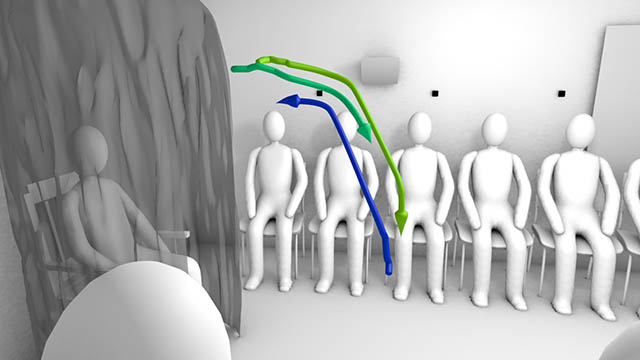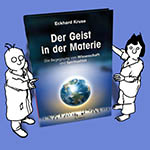Using audio processing to investigate physical mediumship
One of the big challenges for research on physical mediumship is that many phenomena are
occurring only in low-light conditions or in complete darkness. Rather than reiterating the common demand of psi researchers to
install infrared cameras as prerequisite for any type of research, here a different approach is taken, using audio recordings.
With an appropriate setup of microphones and some postprocessing, it is possible to get some interesting information about what is going in the darkness.
On this page, some results for 3D sound source localisation in séances with Warren Caylor are shown.
Some results from forensic voice analysis applied to séance recordings are presented here.
Many thanks to Warren and his spirit team to allow and support these investigations! Also many thanks to Lucius Werthmüller from Basel Psi Association for acquainting me with the area of physical mediumship (which, of course, initially sounded totally weird to me), for establishing the contact with the medium and for many interesting discussions about psi research.
Part of this work has now been published in a peer-reviewed scientific magazine: Eckhard Kruse, Audio signal processing to investigate alleged paranormal phenomena in mediumistic séances, IEEE Aerospace and Electronic Systems Magazine, Volume 33 Issue 2, February 2018, pp. 52-56.
On this page, some results for 3D sound source localisation in séances with Warren Caylor are shown.
Some results from forensic voice analysis applied to séance recordings are presented here.
Many thanks to Warren and his spirit team to allow and support these investigations! Also many thanks to Lucius Werthmüller from Basel Psi Association for acquainting me with the area of physical mediumship (which, of course, initially sounded totally weird to me), for establishing the contact with the medium and for many interesting discussions about psi research.
Part of this work has now been published in a peer-reviewed scientific magazine: Eckhard Kruse, Audio signal processing to investigate alleged paranormal phenomena in mediumistic séances, IEEE Aerospace and Electronic Systems Magazine, Volume 33 Issue 2, February 2018, pp. 52-56.
Sound source localization in séances with Warren Caylor
Recorded April 2016 (in Home Circle):
Notes: A new microphone setup has been used, with a bigger distance between the microphones for more robust position detection.
Recorded in December 2015 (in a public séance):
Notes: A new microphone setup has been used, with a bigger distance between the microphones for more robust position detection.
Recorded in December 2015 (in a public séance):
Motions of ectoplasm / 'voice box'
At the end (and sometimes also at the beginning) of the appearance of the spirit voices, a throaty sound can be heard, which is moving quite rapidly. Supposedly, the direct voices are generated by an ectoplasm 'voice box', on which Yellow Feather commented during a home circle:
'Eckhard, you may find the sound of the ectoplasm, when you plot it, your graph will change in height as it travels. That is because when it is extruded it goes up and then down to the floor. When it goes back, it comes back up off the floor into the air and back down towards the channel. So if you see some unusual changes in height from the sound of ectoplasm, that is why.'
So, here are the graphs of such motions (each one lasting one to two seconds). The arrow heads indicate the direction of motion. Keep in mind that only the audible part of the motion could be captured.

'Eckhard, you may find the sound of the ectoplasm, when you plot it, your graph will change in height as it travels. That is because when it is extruded it goes up and then down to the floor. When it goes back, it comes back up off the floor into the air and back down towards the channel. So if you see some unusual changes in height from the sound of ectoplasm, that is why.'
So, here are the graphs of such motions (each one lasting one to two seconds). The arrow heads indicate the direction of motion. Keep in mind that only the audible part of the motion could be captured.

Notes and technical details
- The animations have been generated based on audio recordings of the séances using four off-the-shelf microphones, indicated by the red dots at the wall.
- The Audio has a sample rate of 48 kHz (2015 recordings) / 96 kHz (2016 recording), stored in wav raw-format without any compression. Bit depth has been set to 24 to cover the unforeseeable dynamic range during the séance.
- To calculate the position of the sound source, standard state-of-the-art algorithms has been used (GCC-PHAT / a slightly modified version of SRP-PHAT) to determine the time difference for the sound travelling to the different microphone positions. It assumes that there is only one sound source at a time. Typically, as can be seen in the video, when different people are speaking, the strongest source is detected (thus favoring sources close to the microphones). There may also be wrong results, but typically these could be filtered out automatically, as they mostly show up as isolated outliers.
- The software being used is written by myself (in Java), putting focus on my requirements for microphone positions, easily navigating in more than two hours of audio data, visualisation of the room, export to a 3d animation software and support of some other analysis such as the forensic voice comparison. (And for a computer guy it's lots of fun to write a software with the name Geisterstimmerlokalisierer - spirit voices localizer - much more exciting than what you find in any App store.)
- The animations have been rendered using Cinema4D. The size of the balls indicate the volume of the sound. Size and position are directly taken from the automatic sound source analysis. Chairs, the cabinet etc. have been added for illustrative purposes to get a better impression of the situation in the room. The camera motions have been added manually to focus on what's interesting and to make the clips look a bit nicer.
References
- Eckhard Kruse, Audio signal processing to investigate alleged paranormal phenomena in mediumistic séances, IEEE Aerospace and Electronic Systems Magazine, Volume 33 Issue 2, February 2018, pp. 52-56.
- C. Knapp and G. Carter, The generalized correlation method for estimation of time delay. Acoustics, Speech and Signal Processing, IEEE Transactions, vol. 24, no. 4, pp. 320-376, 1976.
- Jacob Benesty, Jingdong Chen, Yiteng Huang: Microphone Array Signal Processing, Springer, 2008
- Sakari Tervo, Tapio Lokki: Interpolation Methods for the SPR-PHAT Algorithm. 11th International Workshop for Acoustic Echo and Noise Control (IWAENC 2008), Seattle, WA, USA, September 14-17, pp. Article ID 9037, 2008
- Cha Zhang, Dinei Florencio, Zhengyou Zhang: Why Does PHAT Work Well in Low Noise, Reverberative Environments?. IEEE International Conference on Acoustics, Speech and Signal Processing, 2008


